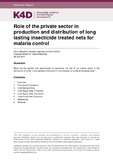| dc.contributor.author | Millington, Kerry | |
| dc.contributor.author | Agboraw, Efundem | |
| dc.contributor.author | Worrall, Eve | |
| dc.date.accessioned | 2017-09-05T08:50:04Z | |
| dc.date.available | 2017-09-05T08:50:04Z | |
| dc.date.issued | 2017-07-28 | |
| dc.identifier.citation | Millington, K.A., Agboraw, E and Worrall E. (2017). Role of the private sector in production and distribution of long lasting insecticide treated nets for malaria control. K4D Helpdesk Report. Brighton, UK: Institute of Development Studies. | en |
| dc.identifier.uri | https://opendocs.ids.ac.uk/opendocs/handle/20.500.12413/13169 | |
| dc.description.abstract | This report provides a review of key literature and evidence on the LLINs and private sector. The evidence base for this report is vast and spans more than twenty years of research evidence, policy documents and implementation programme evaluations and data from sub Saharan Africa and Asia. The relevant literature spans academic publications in biological and social sciences as well as implementation science and health economics. The private sector producing and distributing mosquito nets in malaria control has been exposed to factors beyond usual market influences. The supply of untreated nets was diverse and often local. It was maintained with the introduction of insecticide treatment sachets (supplied by donors) to bundle with untreated nets sold by retailers. Voucher schemes aimed at targeting vulnerable groups e.g. pregnant women and young children aimed to sustain and expand the commercial sector through public private partnership. The biggest influences on the private sector was a huge increase in donor funding of free mass campaigns and the WHO and the Global Malaria Programme change in 2007 in the overall global strategy from targeted protection of vulnerable groups (pregnant women and children under 5 years old) to universal coverage and recommendation of long lasting insecticide treated nets (LLINs) instead of insecticide treated nets (ITNs). The private sector then had to compete with international companies with the technology to produce LLINs; bulk purchasing by donors; higher unit costs; and competition with free distribution by donors through the established network of the healthcare system. | en |
| dc.language.iso | en | en |
| dc.publisher | Institute of Development Studies | en |
| dc.relation.ispartofseries | K4D Helpdesk Report; | |
| dc.rights.uri | https://www.nationalarchives.gov.uk/doc/open-government-licence/version/3/ | en |
| dc.subject | Health | en |
| dc.subject | Private Sector Development | en |
| dc.title | Role of the private sector in production and distribution of long lasting insecticide treated nets for malaria control | en |
| dc.type | Helpdesk | en |
| dc.rights.holder | DFID | en |
| dcterms.dateAccepted | 2017-07-28 | |
| rioxxterms.funder | Default funder | en |
| rioxxterms.identifier.project | K4D | en |
| rioxxterms.version | NA | en |
| rioxxterms.funder.project | 0986883a-6d0f-4bb8-9c46-5e0682934d65 | en |

